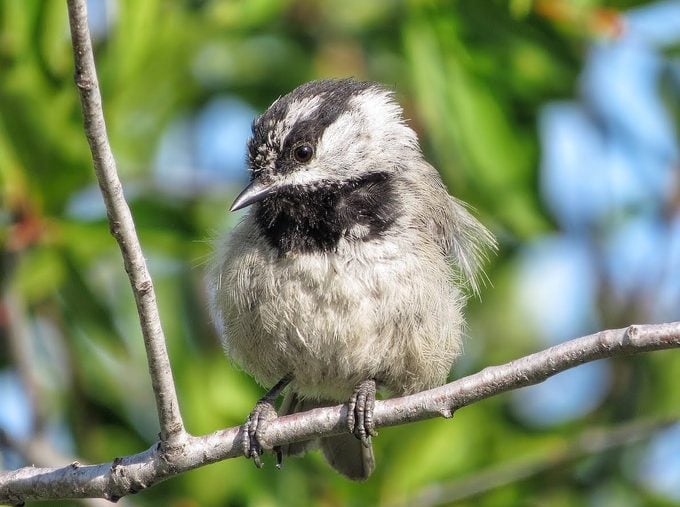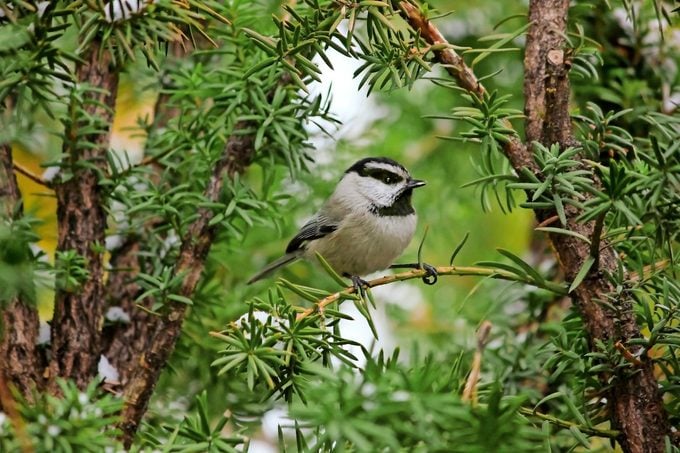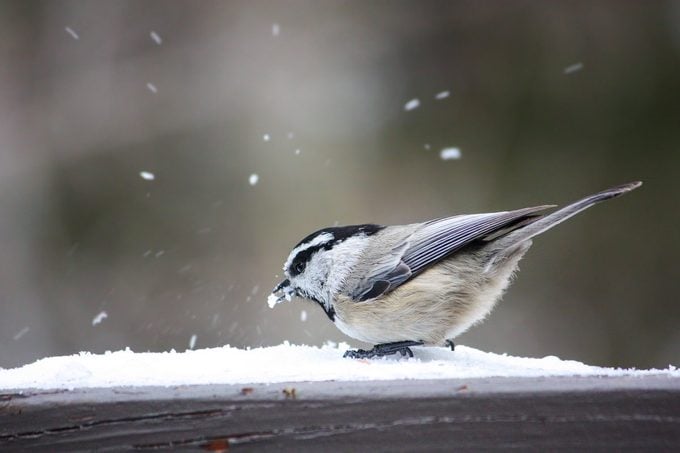How to Identify and Attract a Mountain Chickadee
Updated: Jul. 09, 2024
Learn what a mountain chickadee looks like and sounds like, where to find one, and how to attract one to your bird feeder.
On This Page
Where Does a Mountain Chickadee Look Like?

If you live in the Mountain West, a vocal black, white and gray bird might be a black-capped chickadee or its closest cousin, a mountain chickadee. The two are similar in size, about 4 inches long, with large heads, long tails and small bills. Both have a prominent black cap, white cheeks, light gray to buff sides, and a black throat patch, but only mountain chickadees have a white streak above their eyes.
Meet all the members of the chickadee family.
Mountain Chickadee Sounds
Bird sounds courtesy of the Cornell Lab of Ornithology
Chickadees are very verbose birds. They sing fee-bee when amorous. They scold chick-a-dee, adding more dees the higher their anxiety. And when the risk is acute, such as a soaring hawk overhead, they shriek. “That shriek means ‘freeze’ to the flock,” says Arch McCallum, a retired biology professor and the lead expert on the mountain chickadee for the Cornell Lab of Ornithology’s Birds of The World.
A mountain chickadee’s buzzy call is distinguished from the black-capped by its harsher tone.
Learn how to identify and attract a Carolina chickadee.
Mountain Chickadee Range and Habitat

While black-capped chickadees live in deciduous forests, mountain chickadees prefer to congregate in conifers in western forests from Canada to Texas.
Do Mountain Chickadees Migrate?

Chickadees are nonmigratory, staying within their ranges all year. The only time mountain chickadees migrate is when they leave their mom and dad to find another flock, though they’ll move temporarily downslope during a harsh winter.
Junco vs chickadee: Here’s how to tell the difference.
Mountain Chickadee Nests and Eggs
Mountain chickadees lay eggs in woodpecker holes and other cavities that they line with moss and scavenged fur. They use small nest boxes, too. If you hear a hiss coming from a birdhouse, it might be a mountain chickadee mimicking the sound of a snake to deter an intruder.
The eggs are dull white with red spots. It takes more than three weeks for chicks to hatch and fledge. If the adults need to fetch food during that time, they cover the eggs or hatchlings with a fur “blanket” to hide them.
“Mountain chickadees live in impregnable places behind a lot of wood where the young hang out as long as possible because it’s safe,” Arch says. “When they fly out, it’s full-bore. They’re really ready!”
A flock of mountain chickadees, called a banditry, is typically up to three mated pairs plus several juveniles. (Check out photos of super-cute baby chickadees.) Interestingly, the young birds are usually not the offspring of the pairs in the banditry.
What Do Mountain Chickadees Eat?

Mountain chickadee flocks readily come to feeders for sunflower seeds. They approach one at a time, grabbing a seed and carrying it to a nearby branch. Holding the seed with its feet, the bird pokes decisively at the seam until it breaks apart; the bird then eats the nutritious nugget inside or stashes it for a future meal.
“Mountain chickadees cache their finds in the bark and needles of trees and on the ground,” Arch says. “I’ve seen them fly straight to a place under a tree and pull out a seed. They have special memory for where they’ve put seeds. Their survival depends on it.”
These little sprites are full of life and fun to watch. They will make you smile as they frolic around a feeder and then fly off together.
Next, learn how to tell the difference between a nuthatch vs a chickadee.
About the Expert
Retired College of Charleston biology professor Arch McCallum is the lead expert on the mountain chickadee for the Cornell Lab of Ornithology’s Birds of The World. He earned a Ph.D in biology from the University of New Mexico.






















